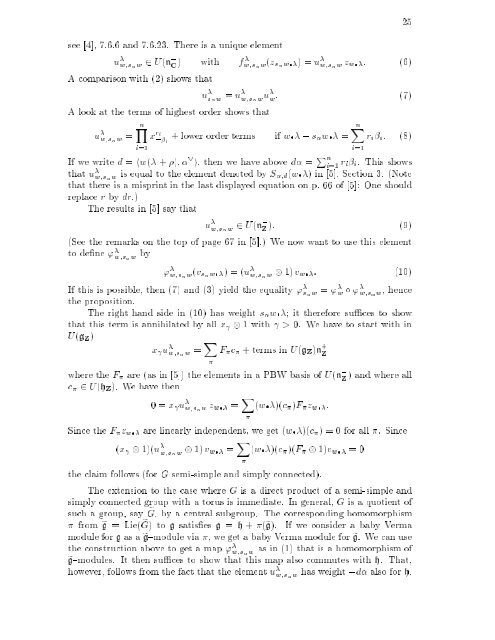subregular nilpotent representations of lie algebras in prime ...
subregular nilpotent representations of lie algebras in prime ...
subregular nilpotent representations of lie algebras in prime ...
You also want an ePaper? Increase the reach of your titles
YUMPU automatically turns print PDFs into web optimized ePapers that Google loves.
see [4], 7.6.6 and 7.6.23. There is a unique element<br />
u w;s w 2 U(n ,<br />
C ) with f w;s w(zs w )=u w;s w zw : (6)<br />
A comparison with (2) shows that<br />
A look at the terms <strong>of</strong> highest order shows that<br />
u w;s w =<br />
nY<br />
i=1<br />
25<br />
u s w = u w;s wu w: (7)<br />
x ri<br />
, +lower order terms if w , s w =<br />
i<br />
nX<br />
i=1<br />
ri i: (8)<br />
If we write d = hw( + ); _ i, then we have above d = P n<br />
i=1 ri i. This shows<br />
that u w;s w is equal to the element denoted by S ;d(w ) <strong>in</strong> [5], Section 3. (Note<br />
that there is a mispr<strong>in</strong>t <strong>in</strong> the last displayed equation on p. 66 <strong>of</strong> [5]: One should<br />
replace r by dr.)<br />
The results <strong>in</strong> [5] say that<br />
uw;s w 2 U(n ,<br />
Z ): (9)<br />
(See the remarks on the top <strong>of</strong> page 67 <strong>in</strong> [5].) We nowwant to use this element<br />
to de ne ' w;s w by<br />
' w;s w (vs w )=(u w;s w 1) vw : (10)<br />
If this is possible, then (7) and (3) yield the equality ' s w = ' w ' w;s w, hence<br />
the proposition.<br />
The right hand side <strong>in</strong> (10) has weight s w ; it therefore su ces to show<br />
that this term is annihilated by allx 1with >0. We have to start with <strong>in</strong><br />
U(gZ)<br />
x u w;s w = X F c + terms <strong>in</strong> U(gZ)n +<br />
Z<br />
where the F are (as <strong>in</strong> [5]) the elements <strong>in</strong> a PBW basis <strong>of</strong> U(n ,<br />
Z ) and where all<br />
c 2 U(hZ). We havethen 0=x u w;s w zw = X (w )(c )F zw :<br />
S<strong>in</strong>ce the F zw are l<strong>in</strong>early <strong>in</strong>dependent, we get(w )(c ) = 0 for all . S<strong>in</strong>ce<br />
(x 1)(u w;s w 1) vw = X (w )(c )(F 1)vw =0<br />
the claim follows (for G semi-simple and simply connected).<br />
The extension to the case where G is a direct product <strong>of</strong> a semi-simple and<br />
simply connected group with a torus is immediate. In general, G is a quotient <strong>of</strong><br />
such a group, say eG, by a central subgroup. The correspond<strong>in</strong>g homomorphism<br />
from eg = Lie( e G)to g satis es g = h + (eg). If we consider a baby Verma<br />
module for g as a eg{module via ,we get a baby Verma module for eg. We can use<br />
the construction above togetamap' w;s w as <strong>in</strong> (1) that is a homomorphism <strong>of</strong><br />
eg{modules. It then su ces to show that this map also commutes with h. That,<br />
however, follows from the fact that the element u w;s w has weight ,d also for h.

















